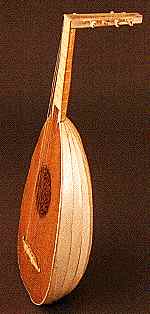Lutes and viols
As is the case today, string instruments were either plucked or bowed. The ancestor of the modern guitar was the cittern, or gittern, was favoured by street performers (see a picture of one), while the lute was more courtly.
Listen to music played on a lute*.
Bowed instruments were also subject to class distinctions. The viol was considered more refined than the precursor of the modern violin, the fiddle. Like lutes and guitar, the viol was fitted with frets (another word that gave rise to punning); "da gamba" in the viol picured in the graphic means that it was large enough to be held between the legs.
Listen to a "broken consort"*.
The Guitar Pre 1650 -- a history of early guitars -- is available on line.
Footnotes
-
A dance for a lute
The dance played here is a "galliard" by the composer Francis Cutting. The lute dates from 1550, and was made in Venice. The cittern is from the same period, and may have been made in Urbino, Italy, the city made famous by Castiglione's book on the courtier.
-
A broken consort
A consort is a group of instruments, usually all of the same kind (a consort of viols, for example would have had several viols of different pitches); a "broken" consort is a mixture of different kinds of instruments. Here recorders play the upper notes while a viol da gamba plays the bass.
